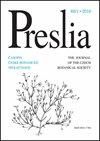二倍体加利福尼亚Ficaria加利福尼亚Ficaria vera亚种与四倍体Ficaria verna亚种的自然杂交。位于欧洲中部的维尔纳
IF 4.4
2区 生物学
Q1 PLANT SCIENCES
引用次数: 3
摘要
榕树属是一个复杂的类群,其多倍体化和杂交有助于分类群的多样化。在中欧,二倍体的加利福尼亚赤霉病和四倍体的verna亚种。Verna偶尔接触,结果是种间三倍体杂交,最近通过分子标记、基因组大小估计和实验杂交证明了这一点。在本研究中,我们旨在估计中欧地区三倍体杂交植物的频率和分布,找出可用于区分杂种和亲本类群的表型性状,并比较三倍体杂交植物和亲本类群的物候、花粉活力、有性繁殖和无性繁殖以及生态位分化。对来自67个地区的1171个个体的流式细胞术分析显示,在89%的两个亲本类群同域居群的样本中,有规律地发现三倍体杂交,在细胞型混合的样本中,平均百分比为19.4%。未发现纯杂交群体。杂种的大部分形态特征介于亲本类群之间,未表现出新的形态特征。最能区分类群的特征是腋芽的产生、败败和发育良好的瘦果、叶片形状和植株习性。几乎所有杂交种都有性不育:花粉活力显著降低(平均8.4%),平均98%的瘦果流产。杂交品种的局部扩散可能是通过在叶腋上产生球茎来实现的,尽管每个节的球茎数量和一个球茎的平均重量在杂交品种中比在verna亚种中低2倍和3倍。弗娜。杂交生态位介于亲本类群之间,但略微向水藻亚群偏移。弗娜。此外,对该杂交品种进行了分类和命名处理,描述为Ficaria ×sellii Duchoslav, Popelka et Trávn。,以及一个关键的识别中欧的Ficaria分类群,提出。本文章由计算机程序翻译,如有差异,请以英文原文为准。
Natural hybridization between diploid Ficaria calthifolia and tetraploid Ficaria verna subsp. verna in central Europe
The genus Ficaria is a taxonomically intricate group in which polyploidization and hybridization contribute to taxa diversification. In central Europe, populations of diploid F. calthifolia and tetraploid F. verna subsp. verna occasionally come into contact, which results in an interspecific triploid hybrid, as recently demonstrated using molecular markers, genome size estimation and experimental crossing. In this study, we aimed to estimate the frequency and distribution of the triploid hybrid in central Europe, to identify those phenotypic traits that can be used to discriminate between hybrid and parental taxa and compare the phenology, pollen viability, sexual and asexual reproduction and niche differentiation of the triploid hybrid and parental taxa. Flowcytometry analyses of 1171 individuals sampled from 67 localities revealed that triploid hybrids were regularly found at 89% of the sites sampled where there were sympatric populations of both parental taxa, with a mean percentage of 19.4% occurring at sites where there was a mixture of cytotypes. No pure hybrid population was found. The hybrids were intermediate between the parental taxa in most morphological characters and did not show any novel morphological characters. The characters that best differentiate the taxonomic groups were the production of axillary bulbils, aborted and well-developed achenes, leaf shape and plant habit. Almost all hybrids were sexually sterile: the pollen viability was considerably reduced (mean 8.4%) and on average 98% of the achenes were aborted. Local dispersal of the hybrids is possible through the production of bulbils in the leaf axils, although the number of bulbils per node and the mean weight of one bulbil were two and three times lower in the hybrid than in F. verna subsp. verna. The hybrid niche was intermediate between those of the parental taxa but shifted slightly towards that of F. verna subsp. verna. In addition, the taxonomic and nomenclatural treatment of the hybrid, which is described as Ficaria ×sellii Duchoslav, Popelka et Trávn., as well as a key for identifying the central European taxa of Ficaria, are presented.
求助全文
通过发布文献求助,成功后即可免费获取论文全文。
去求助
来源期刊

Preslia
生物-植物科学
CiteScore
5.20
自引率
29.40%
发文量
8
审稿时长
>12 weeks
期刊介绍:
Preslia is a peer-reviewed scientific journal publishing original research papers on plant systematics, morphology, phytogeography, ecology and vegetation science, with a geographical focus on central Europe. The journal was founded in 1914 and named in honour of brothers Jan Svatopluk Presl (1791–1849) and Karel Bořivoj Presl (1794–1852), outstanding Bohemian botanists. It is published quarterly by the Czech Botanical Society.
 求助内容:
求助内容: 应助结果提醒方式:
应助结果提醒方式:


